The rear suspension of the car differs in design, depending on the model
In the article, we will consider the rear suspension of a 2WD and 4WD car.
Rear suspension of a 4x2 car
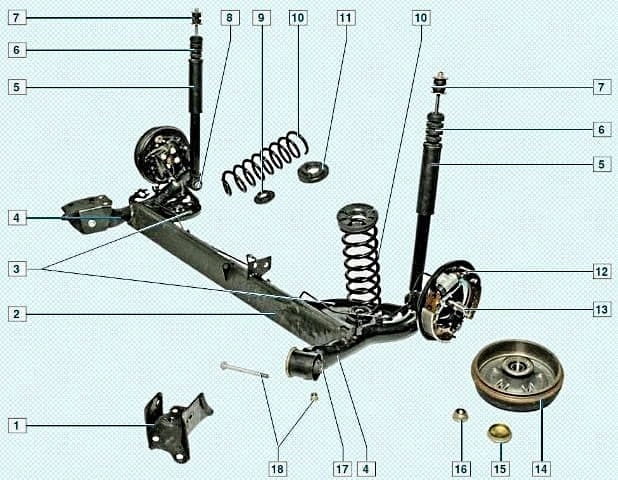
Rear suspension elements: 1 - bracket for fastening the beam arm to the body; 2 - beam; 3 - lever bracket; 4 - beam lever; 5 - shock absorber; 6 - compression stroke buffer; 7 - pillows and washers of the upper attachment of the shock absorber to the body; 8 - a bolt of fastening of the shock-absorber to the lever; 9 - lower spring gasket; 10 - spring; 11 - upper spring gasket; 12 - brake mechanism of the rear wheel; 13 - trunnion of the rear wheel; 14 - brake drum assembly with rear wheel bearing; 15 - cap; 16 - wheel bearing nut; 17 - silent block of the beam lever; 18 - bolt and nut for fastening the beam lever to the bracket
Rear suspension - semi-independent elastic beam, spring with double-acting telescopic shock absorbers.
U-beam with trailing arms welded to it.
The beam is rigid in bending, works in twisting, acting as a torsion bar.
This allows the wheels of the rear axle to move in a vertical plane independently of each other within certain limits.

This design of the suspension brings it closer in terms of comfort to an independent suspension, but it is cheaper and easier to manufacture.
Brackets for spring support are welded to the beam and levers.
To increase lateral stability and reduce roll angles, a stabilizer bar is installed inside the beam, the ends of which are welded to the lever amplifiers.
The stabilizer is a pipe - round at the edges, and oval in the middle.
Flanges are welded to the suspension arms for mounting the axles of the rear wheels and the shields of the brake mechanisms.

Front, the arms are equipped with welded bushings, with silent blocks pressed into them, which are designed to articulate the suspension arms with the body.
The outer cage of the silent block is plastic, and the inner cage is metal.
The rubber mass of the silent block, vulcanized to the clips, is asymmetrical in cross section.
Therefore, when pressing the silent block into the lever, it must be strictly oriented.
The elastic elements of the suspension are coil springs.

The spring rests through rubber gaskets: from below - on the arm bracket and from above - on a support welded to the side member of the body.
The spacers prevent the transmission of high-frequency vibrations of the suspension to the body.
By avoiding steel-to-steel contact, gaskets also eliminate knocks and squeaks.
The lower coil of the spring has a smaller diameter.
Rear suspension springs are divided into classes according to stiffness.
Spring class is marked with paint. Springs of the same class must be installed on the right and left sides of the car.
When replacing, it is recommended to install springs of the same class that were installed on the car.
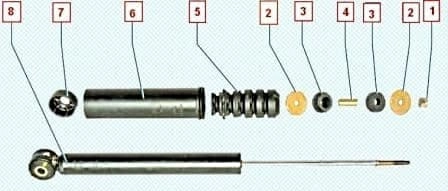
Rear suspension shock absorber: 1 - stem mounting nut; 2 - washer; 3 - rod cushion; 4 - spacer sleeve; 5 - compression stroke buffer; 6 - cover; 7 - protective cap; 8 - shock absorber
A rubber-metal hinge is pressed into the lower eye of the shock absorber, through the central sleeve of which a bolt passes, connecting shock absorber with suspension arm.
The shock absorber rod is attached to the body through two rubber pads (one at the bottom of the support, the other at the top) and two metal washers.
A spacer sleeve is installed between the cushions on the shock absorber rod, which prevents the cushions from being severely deformed when the stem nut is tightened.
The shock absorber is fitted with a compression stroke buffer to which the boot is attached.
The buffer serves to limit the upward movement of the wheel.
Prevents deformation and breakage of suspension elements, and also eliminates the transfer of shock loads to the body.
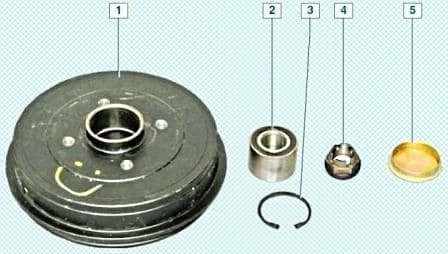
Rear wheel bearing assembly; 1 - brake drum; 2 rear wheel bearing; 3 - retaining ring of the bearing; 4 - bearing nut; 5 - cap
Double-row rear wheel bearings.
The role of the rear wheel hub is performed by the brake drum, in the hole of which the outer ring of the bearing is installed with an interference fit.

The inner rings of the bearing are mounted on the trunnion (axle) of the rear wheel - with a small gap.
In the drum, the bearing is fixed with a retaining ring
During operation, the bearing does not require relubrication.
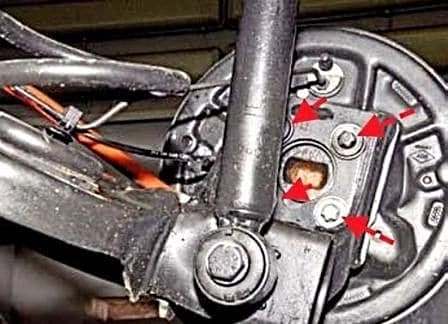
The installation angles of the rear wheels are specified by the beam geometry and cannot be adjusted in operation.
Angles can only be checked on a special stand and compared with control values.
If the values of the rear wheel alignment angles do not correspond to the control values, it is necessary to check the condition of the rear suspension elements.
Possible malfunctions of the rear suspension of a 4x2 car
Noise and knock in the suspension when the car is moving:
Shock absorber defective - Replace shock absorber
Loose shock absorber mounting or worn shock absorber lug bushing - Tighten the shock absorber lower mounting bolt and nut or replace the bushings
Worn trailing arm bushings - Replace bushings
Settlement or broken spring - Replace spring
Faulty wheel bearing - Replace bearing
Moving the car away from straight ahead:
Inflated tire pressure - Set correct tire pressure
Wheel tires have different wear or tread pattern - Change tires
Camber out of alignment - Eliminate cause of camber out of alignment
Settlement or breakage of one of the springs - Replace the spring
Deformation of trailing arms - Replace silent blocks
Increased or excessive tire tread wear:
Tire pressure not correct - Set correct pressure
Wheels misaligned - Remedy for misaligned wheels
Overloading the vehicle - Avoid overloading the vehicle
Wheel imbalance - Balance the wheels
Rear suspension of a 4x4 car
The rear suspension is independent, multi-link with coil springs and telescopic shock absorber struts, which serve to dampen vibrations, absorb shocks and shocks acting on the car body through its wheels.

Rear suspension of a 4x4 car: 1 - rear wheel hub; 2 - fist; 3 - shock absorber; 4 - anti-roll bar; 5 - bar of the anti-roll bar; 6 - subframe; 7- front transverse lever; 8 - rear transverse lever; 9 - body bracket; 10 - trailing arm
Shock absorber struts include elastic elements - springs that prevent the wheels from coming off the road, ensuring constant traction.
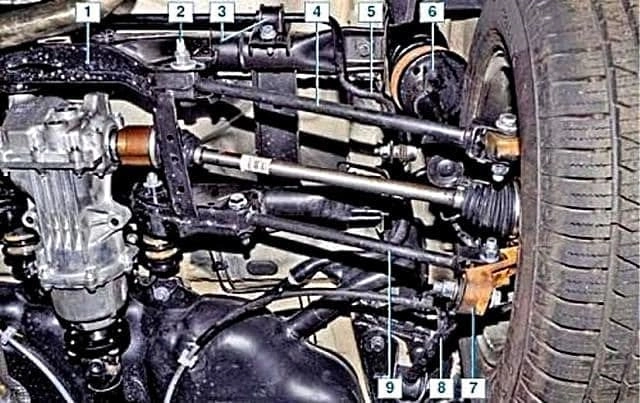
Elements of the rear suspension on the car: 1 - subframe; 2 - bolt with eccentric washer; 3 - bracket for fastening the bar of the stabilizer bar; 4 - rear transverse lever; 5 - bar of the anti-roll bar; 6 - shock absorber; 7 - fist; 8 - trailing arm; 9 - front wishbone
Shock absorbers of the struts prevent body vibrations, which accordingly affects the safety and comfort of movement.
The shock strut at the bottom is attached to the knuckle with two bolts and nuts, and the upper strut support is attached to the body with a nut.
The right and left shock absorbers are interchangeable.
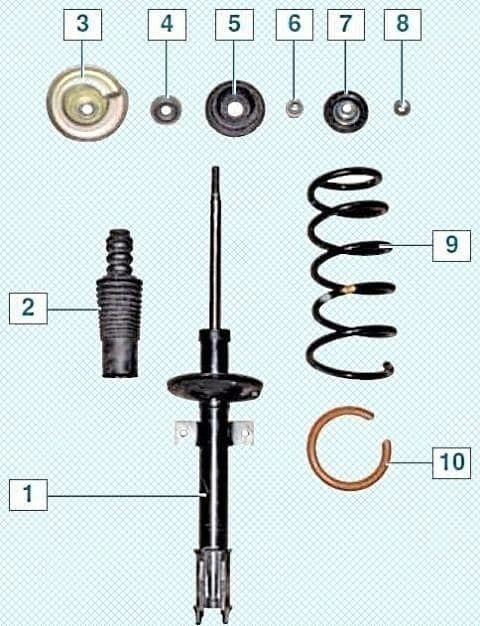
Elements of shock absorber strut: 1 - telescopic strut; 2 - compression stroke buffer with a protective cover; 3 - upper support cup of the spring; 4 - bearing of the upper support; 5 - top support of the rack; 6 - nut for fastening the upper support; 7 - rubber-metal support washer; 8 - nut for fastening the shock absorber to the body; 9 - spring; 10 - vibration-absorbing spring cover
The fist is connected through silent blocks by two transverse levers to the rear suspension subframe and one trailing arm to a bracket mounted on the body.
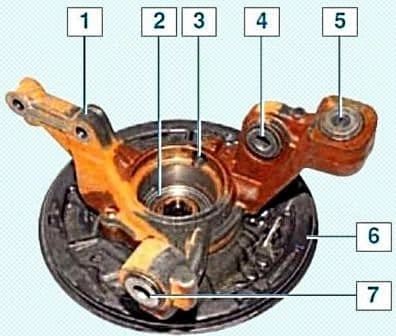
The left fist of the rear suspension: 1 - fist; 2 - rear wheel hub bearing; 3 - hole for the ABS sensor; 4 - silent block of the front transverse lever; 5 - trailing arm silent block; 6 - brake shield; 7- rear wishbone silent block
Braking and traction forces during vehicle movement are perceived by trailing arms, and forces in the direction perpendicular to the longitudinal axis of the vehicle are perceived by transverse suspension arms.
The left and right rear suspension knuckles are non-interchangeable.
In the knuckle, a double-row closed-type angular contact ball bearing is installed, which is secured in the knuckle with a retaining ring.
The wheel hub is installed with an interference fit in the inner rings of the bearing.
The inner races of the bearing are tightened (through the hub) with a nut on the shank of the wheel drive outer joint housing.
In operation, the bearing is not adjustable and does not require relubrication.
The wheel hub nuts are the same, with right-hand threads.

An anti-roll bar is installed to increase lateral stability and reduce body roll angles.
The ends of the stabilizer bar are connected to the shock absorber struts through struts with ball joints.
The stabilizer bars are interchangeable.
The stabilizer bar is attached with two brackets through rubber split cushions to the rear suspension subframe.
The rod is made of spring steel.
From the angles of the rear wheels, only their convergence is regulated.

The rear wishbone is connected to the subframe with a bolt having an eccentric belt and an eccentric washer.
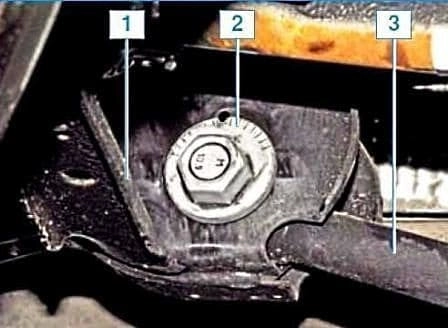
Turning this bolt adjusts the toe of the wheel.
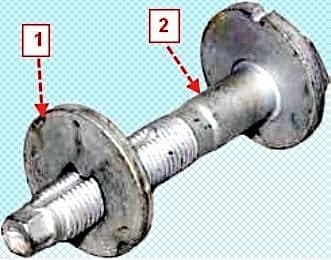
When the bolt with the washer is rotated, its position in the subframe hole changes: when the bolt is moved to the longitudinal axis of the vehicle, the rear transverse arm overhang decreases and, consequently, the wheel toe angle decreases; when the bolt moves away from the axis, the angle increases.
The camber angle is set by the suspension geometry and cannot be adjusted in operation.
The angle can only be checked on a special stand and compared with control values.
If the angle values do not correspond to the control values, it is necessary to check the condition of the rear suspension elements.
Possible malfunctions of the rear suspension of a 4x4 car
Noise and knock in the suspension when the car is moving:
Shock absorber defective - Replace shock absorber
Loose strut mounting or worn upper strut mount pads - Tighten upper strut mount or replace pads
Worn trailing arm bushings - Replace bushings
Settlement or broken spring - Replace spring
Rear wheel hub bearing failure - Replace bearing
Moving the car away from straight ahead:
Unequal tire pressure - Set normal tire pressure
Wheel tires have different wear or tread pattern - Change tires
Camber out of alignment - Eliminate cause of camber out of alignment
Settlement or breakage of one of the springs - Replace the spring
Trailing arms warped - Replace rear suspension beam
Worn trailing arm bushings - Replace bushings
Increased or uneven tire tread wear:
Tire pressure not correct - Set correct pressure
Wheels misaligned - Remedy for misaligned wheels
Overloading the Vehicle - Avoid Overloading the Vehicle
Wheel imbalance - Balance the wheels
Pay attention to the exhaust system.
Extraneous knocks emitted by it are often mistaken for a knock in the rear suspension.
The use of non-standard parts or a break in the silencer suspension elements can cause a strong knock, especially when re-gassing.
To check, stop the engine, inspect the exhaust system, check the soundness of the mounting and suspension of the muffler.
Holding the end of the exhaust pipe, shake the muffler up and down and from side to side - there should be no knocks.





